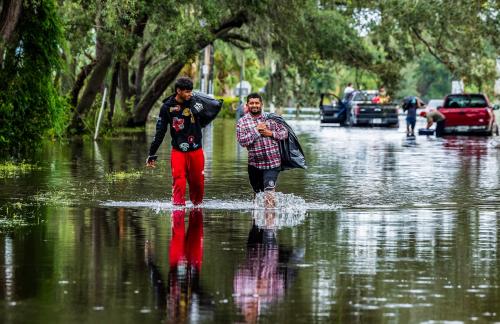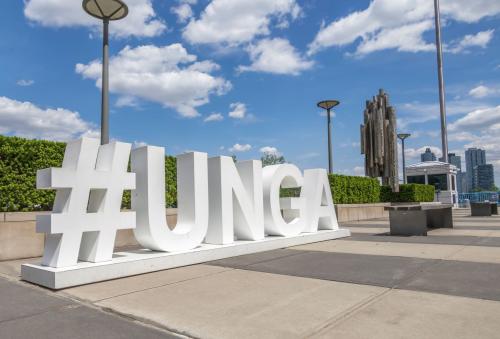Last week’s television images of desperate Burmese victims of the Nargis cyclone were followed almost immediately by reports of equally desperate Chinese searching for relatives in the rubble of a disastrous earthquake in Sichuan. These are terrible tragedies. When the statistics are finally compiled, they are likely to have resulted in tens of thousands, perhaps hundreds of thousands, of deaths.
But every year for the past twenty years, more than 200 million people have been affected by natural disasters, most of which never make it to the nightly news in America. Yet the effects of even localized disasters are felt by affected families for years – long after the TV cameras have moved on to the next disaster.
Observation number 1: The impact of a disaster is not felt evenly across communities. The human pain of natural disasters is profound, but already-vulnerable or marginalized individuals often suffer the most. People affected by natural disasters often lose family members, homes, land and property. They also lose their documentation – identity cards, birth certificates, passports and property titles – which may make it difficult to access public services. However, groups which were already vulnerable before the disaster tend to suffer disproportionately from the devastation. For example, globally, for every one adult male who drowns in a flood, there are 3-4 women who die. Most obviously, this is because in many countries girls are less likely to learn how to swim or climb trees than boys. Vulnerable groups also experience discrimination in the provision of assistance. In many camps where persons displaced by natural disasters live, food is — at least initially — more likely to go to healthy and strong men than to children or the disabled. And in New Orleans, it was the elderly, the immigrants and African-American communities who disproportionately suffered the effects of Hurricane Katrina.
Observation number 2: Poverty exacerbates a disaster’s impact. Chances of surviving a natural disaster are much higher in developed countries than in developing ones. For example, in 1988, an earthquake registering 6.9 on the Richter scale hit Armenia, killing some 55,000 people and leaving 500,000 homeless. Less than a year later, in an even stronger earthquake, 7.1 on the Richter scale, hit San Francisco, California, killing 62 and leaving 12,000 homeless. Recovery is faster in wealthier countries. Access to assistance is often more readily available, and the delivery of that assistance is easier with paved roads and multiple communication networks. The spread of disease is less likely when medicine is on hand, sanitation can be addressed, and functioning hospitals are nearby. Furthermore, preventive measures are more likely to have been implemented where they are economically feasible; advanced levee systems, strategic urban planning, and earthquake-reinforced public buildings are seen as luxuries in many parts of the world.
Observation number 3: The government’s response to a disaster is inherently political. The way in which a government responds to natural disasters is often politically motivated and almost always has political consequences. If it responds quickly and effectively it can enjoy increased credibility and respect from its people. But if it bungles the relief effort, it may be irreparably weakened. For example, many date the fall of the Somoza regime in Nicaragua to its ineffective response to the disastrous 1972 earthquake. Presently the apparent openness of news reporting on the Chinese earthquake stands in contrast to the staged scenes of disaster relief in Burma. It is too early to judge the long-term political repercussions of the response to these two disasters, but there are likely to be consequences. Similarly, the governments’ motivations in responding to disasters are influenced by state interests and impacted by both domestic and international political pressures.
Observation number 4: The international aid regime is imperfect. The community of governmental agencies, NGOs, and UN organizations that provides emergency relief when disasters strike can respond quickly and effectively, but such operations are far from perfect. The community excels in logistical expertise, in mobilization of funds, and in long-tested methods for getting relief to needy people quickly and fairly. Increasingly, the international community is incorporating a human rights perspective in its disaster relief efforts, as witnessed by the adoption by UN agencies of Operational Guidelines on Human Rights and Natural Disasters. But it is much more difficult to mobilize support to warn, prepare and support communities likely to experience the effects of natural disasters.
Observation number 5: Climate change forecasts frequent and worsening disasters. Climate change affects natural disasters, both sudden-onset environmental events and long-term phenomena such as sea level rises. In fact, the severity and frequency of disasters, particularly what are called hydrometerological disasters (cyclones, hurricanes, flooding, mudslides, drought) are increasing. Natural disasters will be with us for a long time. While we cannot control where an earthquake will strike or a cyclone will turn, we can strengthen our collective ability to respond to these disasters and to mitigate their worst effects. And given the projections of the impact of climate change on natural disasters, we have no time to waste.
The Brookings Institution is committed to quality, independence, and impact.
We are supported by a diverse array of funders. In line with our values and policies, each Brookings publication represents the sole views of its author(s).



Commentary
Op-edBeyond the Headlines: Five Observations on Natural Disasters
May 15, 2008